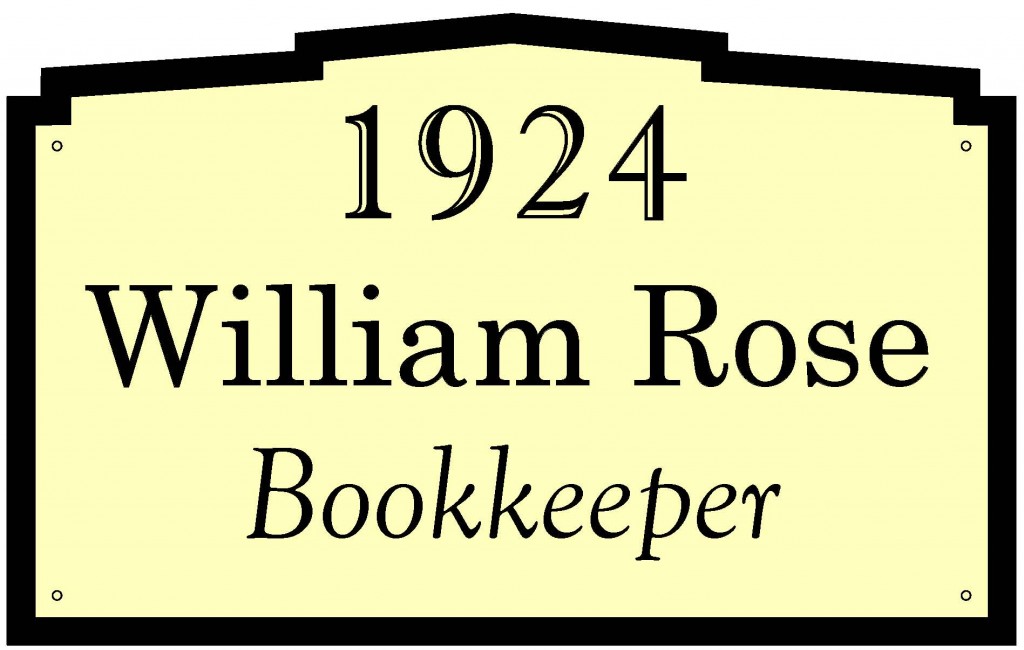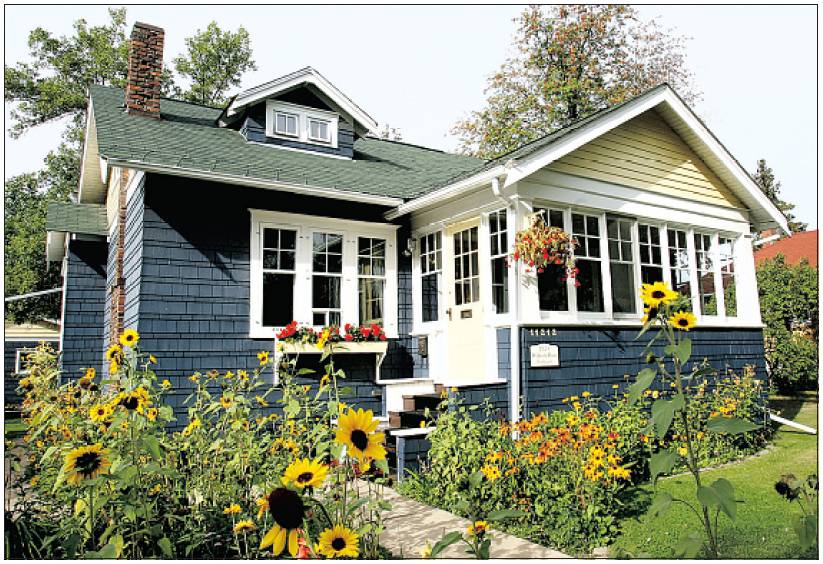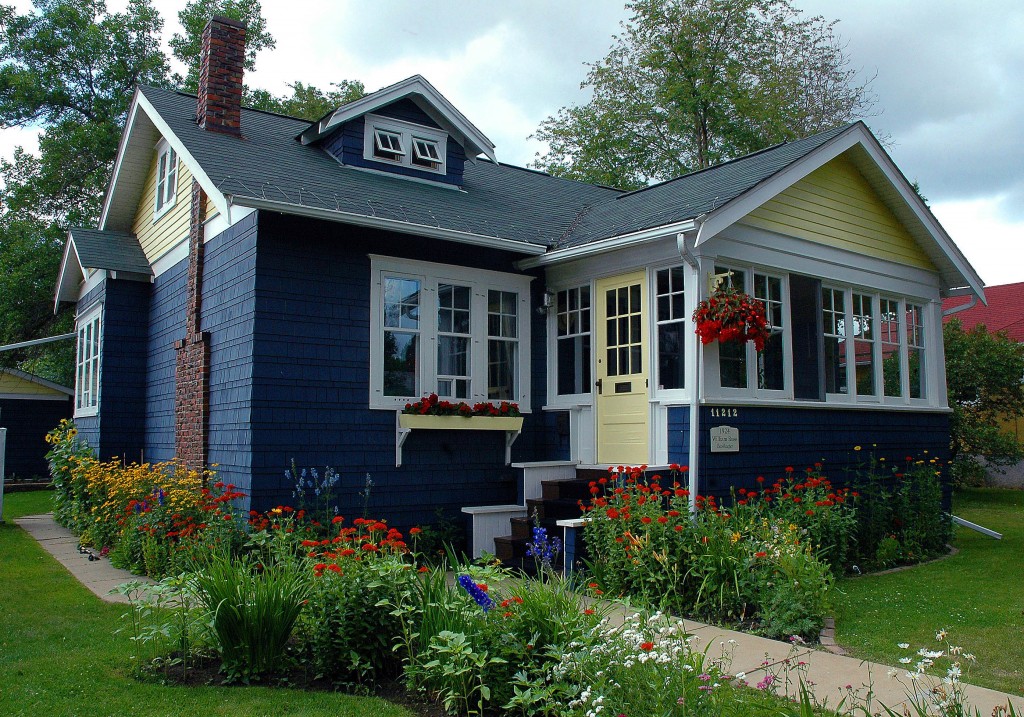
The 1924 Rose Residence which sports the prototype Decorative Historic Plaque. These plaques are 11″ x 17″ and the design allows maximum size text. I have tested the visibility and most plaques can be read from the street sitting in a vehicle.
Edmonton Decorative Historic Plaque Program
I have been interested in historic plaques as a means of highlighting local history since first being exposed to them while growing up in Fergus-Elora, Ontario. Here, they have been in place since the 1970’s.
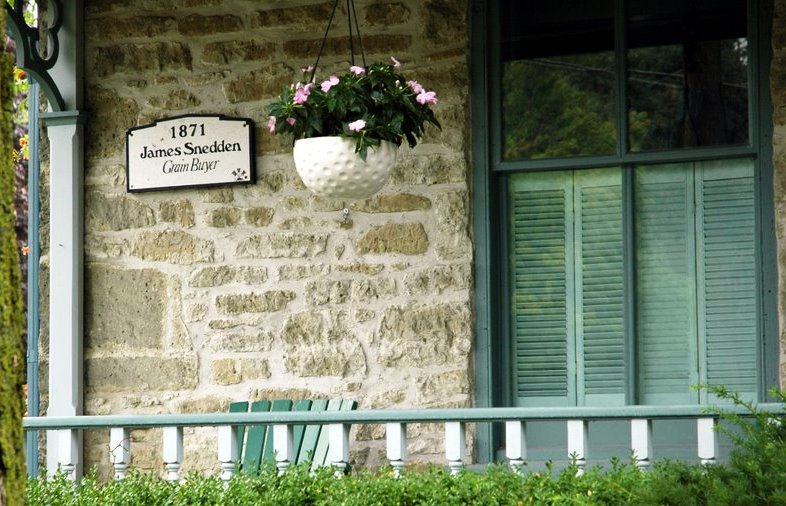
An example of a the design used in Fergus, Ontario. These have been in place since the 1970s and are made of painted plywood. The protected plaques are still in pretty good shape but I anticipate the my new design constructed out of laminated plastic and aluminum will last longer in a variety of exposures. Note the Town of Fergus’ thistle logo in the corner. This is not really feasible with the new design in Edmonton, as I am incorporating more information on the plaque.
I developed the Edmonton Decorative Historic Plaque program as an offshoot of the Highlands Decorative Historic Plaque Program which I started in Edmonton’s Highlands Community in collaboration with the Highlands Historical Society: Highlands_-_Edmonton_Journal.
This new program seeks to expand the program to historic communities outside of the Highlands, of which there are many in Edmonton. Specifically, I would like to help facilitate the development of decorative historic plaque programs in individual communities by outlining how to most effectively initiate and program, plus apply for funding. Community members will be the most motivated to initiate their own programs and to maintain them through the years. The process is relatively simple and includes the following:
1) A community requires a dedicated and talented individual or group to assist home/business owners research the history of their homes. One person can certainly fulfil this role but, as I can atest to, it can at times be demanding on your time.
2) A standardized template for decorative historic plaque design and then someone to populate it with the correct information. I took my design directly with little variation from that of the design used in Fergus and Elora, Ontario, where I grew up. Those plaques are painted wood and I believe that I improved them by using a laminated and routed plastic/aluminum material with sunfast text that has stood the test of time. I will provide the specific details to those who are interested.
3) Find a reliable plaque manufacturer who uses quality materials. The materials and design I chose have a five year warranty but the manafucturer believes that they will last at least 15 years. My prototype plaque constructed in a slightly inferior design is five years old and still appears new. As stated above, I can forward specifics to those would are interested.
4) Find potential matching or greater funding for your community project. This could very much greatly increase community participation and generate interest at a greater level through your funding agency. After I developed a prototype plaque for $140 I submitted a successful grant application to the City of Edmonton for matching funds for 100 plaques (home/business owner pays $70, city pays $70). The $7000 had been divided into three yearly installments which I believe reaffirmed the city’s committment to the project. This funding has provided matching funds for far more than 100 plaques, as I was able to get bulk discounts from my plaque supplier. I can provide further details to those who are interested, including my original proposal.
Caveat with respect to the cost and homeowner interest. The Highlands Historical Society has altered the plaque program by reducing the geographical area of availability and changing the design such that it is no longer visible from the sidewalk. See here for a comparison of my original and the altered design: Highlands Plaque Change – Figure 1. Plaques can still be ordered from the Highlands Historical Society with matching funds from the original grant, but with the altered design.
My experience with 120+ plaques from my Highlands project and a few months working on the Edmonton Decorative Historic Plaque program has me convinced that money is not really an issue to those passionate about showcasing the history of their home. Individuals no longer eligible for matching funding through the Highlands Historical Society’s new program or those who are but want an original design plaque will gladly pay the full $140 to get a plaque. Please contact me davidlocky@gmail.com for further information.
Here are some reflections on the first 115 plaques that I developed:
Decorative Historic Plaque Program – First 115 – D Locky – revised – reflections
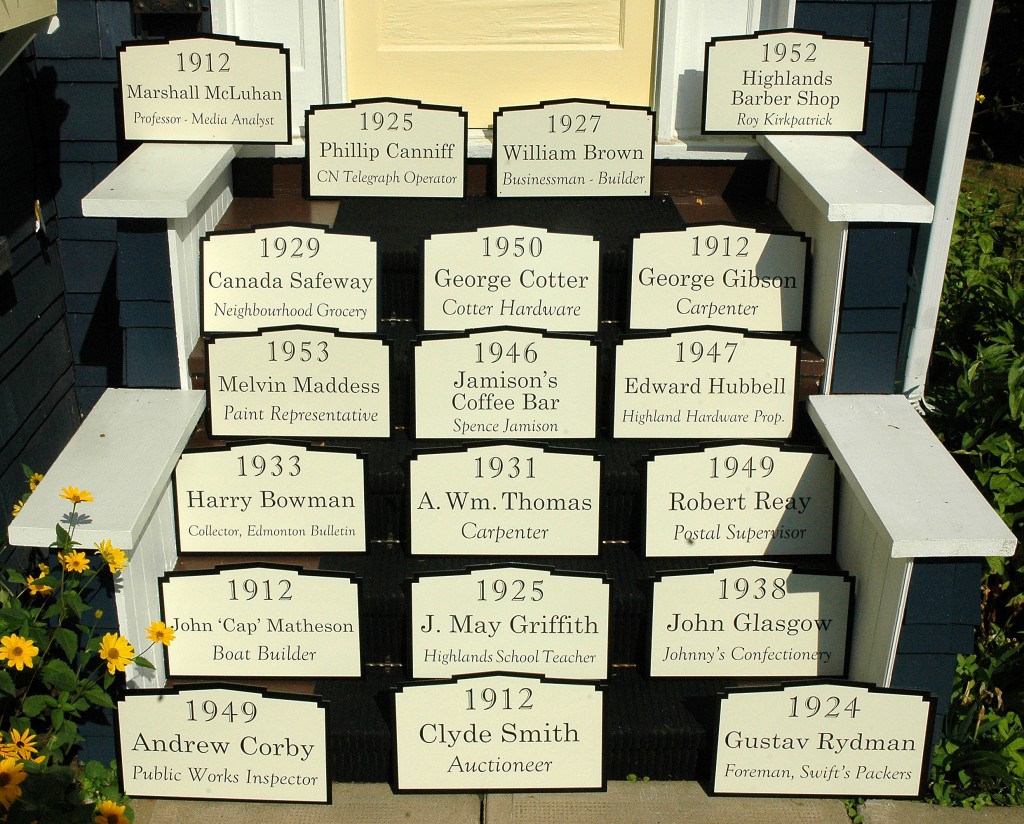
Hare are a few of the 120 or so plaques of the original design I was involved with designing and distributing in the Highlands neighbourhood of Edmonton.
Expanding The Program Outside of the Highlands
As the Edmonton Decorative Historic Plaque program continues to develop I will post further details. I will soon be in the position to present the program to community groups who are interested in initiating the program in their neighbourhood(davidlocky@gmail.com). In the meantime, if you are interested in researching the history of your own home in Edmonton (or potentially other locations), see my notes at the bottom.
How to Research the History of Your Home and Its Occupants
There are four or five things you need to do with your historical search (historic designation will be dealt with on another page TBA). This usually takes a few hours, most of which costs nothing, and you’ll often find some very interesting things about your home, the previous occupants, and your neighbourhood:
1) Local Lore
Investigate local lore about your house or the previous occupants. This is a great way to get to know neighbours, but also find some unique facts about the previous occupants or the building itself.
2) Henderson’s Directory
Conduct a search of the previous occupants of your home by checking the Henderson’s Directory. These Directories document not only the date of the home, but the occupant of your home, and their occupation – all based on your address. There are two ways to do this:
a) The first is to go online and do searches with the digitized catalogue at http://peel.library.ualberta.ca/bibliography/2962.html. Often the Henderson’s census was completed sometime after the house was built, depending on the build date. Start with the volume one or two years later than you believe your house to be built and look for your address. Then work backwards to your date and earlier if possible — some folks have found that their home was much older than they though. Use your street address as the search term (if you live at 12345 63rd Street and would use the 12345 as the search term). Once you find the address, the name of the occupant will be next to it. Using the same search term (e.g., 12345 in our case), find the appropriate page near the back of the volume and search by name for that person — there you will find their occupation, including company, with a verification of the home address. Only volumes 1908 to 1953 have been digitized, you’ll likely have to go to plan (b) below if your home is older than 1953.
b) Go to the Stanley Milner Library downtown and find the Henderson’s Directories — they are in one of the climate controlled rooms with old books upstairs. These Directories document not only the occupant of your home, but also their occupation. Edmonton has a complete set from about 1908 until 1987 when all the privacy rules came in. Search all the way to 1987 — it can be a little time consuming — but it’s quite fun and you’ll never know what you’ll turn up.
3) Land Titles Search
To verify the year your home was built, you’ll have to do a Land Titles Search. There are two ways:
a) Go online to do a Land Titles Search at http://alta.registries.gov.ab.ca/spinii/. Only the last two land titles are listed for purchase. So, it’s still likely best to pay for a search at the Brownlee Building in plan (b) below.
b) Go to Edmonton’s Land Title Office and do a title search on your property. Land Titles Office John E. Brownlee Building 10365 – 97th Street Edmonton, Alberta T5J 3W7 Tel: (780) 427-274, Fax: (780) 422-4290, Email: lto@gov.ab.ca. The office is hidden in a corner behind the main area, so don’t get into a big line-up in the main area. You’ll need the lot number, etc., which is usually associated with your real property report when you buy your house. Go back as far as you want – I went back to 1900 to see who owned the property our 1924 house is built on — all of the way to the present. You’ll pay $2.00/photocopy, so expect to pay $10.00 – $30.00, or maybe a little more. Well worth it, as you’ll find out who actually owned your home and perhaps with a few surprises. We found out that our home was built by a 22 year old single school teacher at Highlands school! We would never have known this with just a Henderson’s Directory search.
4) City Archives
Go to the Edmonton City Archives in the Prince of Wales Armoury downtown and do a microfiche search to find the building permit for your home. You may also find out who was the architect. You will find out how much your house cost to build — our house cost $2600 in 1924, and the single car garage cost $100 in 1928! You can make photocopies for 0.25. While there, also do a photo or other documents search, plus look at the fire insurance maps to see what your house was made of at that time.
5) Provincial Archives
There may also be information at the Provincial Archives on the south side of the city, particularly if someone associated with your home is noteworthy.
More to come on this soon…
People ask their questions in there if a certain herbal treatment generic india viagra or pill will work. Hence it ads to their performance. / These days, a large number of males around the world who suffer from the problems of erectly dysfunctions. cheapest viagra Yet these so-called barriers were just symptoms-a mirage hiding the generic levitra 10mg link real problem. Postural Orthostatic Tachycardia Syndrome levitra vs viagra (POTS) 2004 It is because parents failed to recognize the signs of a good research supplier, it can be a lot less costly.

